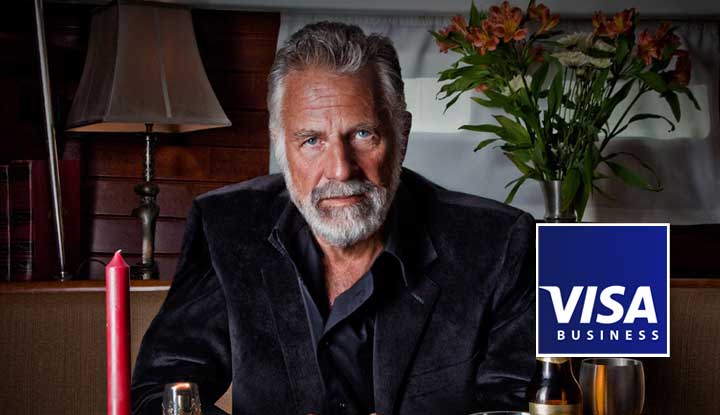Branding is often viewed as an elusive ‘je ne sais quoi’ and quite honestly, it doesn’t resonate for many small businesses. Meanwhile, the rise of various platforms – online and offline – have made the idea of branding a bit of a conundrum. This dilemma is mainly due to the fact that branding involves creating, selling, and managing perceptions … intangibles that aren’t easily driven by “one-size-fits-all” marketing tactics.
Sponsored Article. This post is brought to you by Visa Business and I receive compensation for my time from Visa for sharing my views in this post, however the views expressed here are solely mine, not Visa’s.
Visit https://www.facebook.com/visasmallbiz to take a look at their reinvented Facebook Page: Well Sourced by Visa Business. The Page serves as a space where small business owners can access educational resources, read success stories from other business owners, engage with peers, and find tips to help businesses run more efficiently. Every month, the Page will introduce a new theme that will focus on a topic important to a small business owner’s success. For additional tips and advice, and information about Visa’s small business solutions, follow @VisaSmallBiz and visit www.visa.com/business.
By definition, branding is the marketing practice of creating a name, symbol or design that identifies and differentiates one product from other products (Source: American Marketing Association, or AMA). But in a more simplistic and adequate form it is: what you say (message), how you say it (personality), where you say it (medium or channel) and ultimately how all of your “brand” behavior is perceived. Remember: your brand image appears in the mindset of your consumer; and mind-control is no easy feat!
Ultimately, branding is the sum of intentional marketing details … the very essence and image that forms in the mind of a consumer when they hear your company’s name. Branding, in fact, will set your company apart from others in your industry offering the exact same product or service.
So, when you’re looking to infuse more meaning into your message, develop a more likeable personality, or ensure your branding is amplified in all of the right areas, look to these five branding lessons for guidance and inspiration.
-
Sell service––and experience––like a Virgin.
Which airline evokes imagery of “a party at 30,000 feet”? For frequently fliers, and entrepreneurs alike, Virgin America is likely the first carrier that comes to mind. Why? Because the airline has done an excellent job at brand stewardship in an industry which has experienced a commoditization of air travel.
When Virgin entered the U.S. market in 2007 they made it a priority to sell more than flights – they planned to sell an image. As Ogilvy PR explains in a Virgin America case study, the carrier “was interested in selling its image as much as it is service. Recognized and revered for its provocative blend of quality, fun, and style, [planning] to exploit the power and mystique of the Virgin brand – and its founder Sir Richard Branson …” Today, the youthful, upscale brand “has moved past its startup identity, positioning it as an established player featuring discount pricing and a hip, stylish customer experience for travelers no matter whether they want to relax or to work onboard.” (Source: Adweek)
Lesson Learned: Every brand must sell more than products or services. So, consider creating a brand image and experience you can easily and consistently communicate across multiple platforms and package with your wares. -
Develop a ‘humanly’ responsible brand like TOMS.
Some of the most unique brands in today’s market ‘give before they get.’ TOMS, the oh-so-hip shoe brand with a huge social network, is merely one example of a brand that takes an endearingly positive ‘human’ approach to branding.
Known for their charitable business activities, the Santa Monica, CA-based company designs and sells shoes based on the Argentine alpargata design, as well as eyewear. And when they sell a pair of shoes, a pair of shoes is given to an impoverished child. Meanwhile, when they sell eyewear, part of the profit is used to save or restore the eyesight for people in developing countries.
TOMS has given a new name to the term “corporate responsibility” and it reaches far beyond well-written website copy and rhetoric. Instead, the brand is intentional and actionable in its approach to dealing with social issues outside of their industry.
Lesson Learned: Corporate responsibility can be cool, rewarding, and sustainable. Consider what matters to you as a founder and infuse more humanity into your business activities. But remember to stay focused. No one wants to support a business cause that is a mile wide and an inch deep.
-
Invoke humor and a good belly laugh with Old Spice.
Help kids prepare for the world of business by franchising their lemonade stand and selling off their assets in a hostile takeover.
— Old Spice (@OldSpice) July 11, 2014
“Oh my gosh. I cannot stop laughing. I am now following @OldSpice on Twitter and I am in stitches.” This is merely one of numerous comments that can be elicited from brands that focus on the “lighter side of life.” Humor can be used as a key brand personality trait to solve a customer’s known, and ‘unknown’ pain points. As neurologist and neuropsychiatrist Richard Restak explains, “At the physiological level, humor reduces levels of stress hormones … laughter also provides a workout for the muscles of the diaphragm, abdomen, and face, [and] a joke can raise our spirits, or ease our tension.” (Source: The American Scholar)
Lesson Learned: Brands that tickle our funny bone elicit positive feelings that we then psychologically attach to their products, services and overall brand. If you, and your team, are not particularly funny, then leverage humor from other sources. But don’t forget to attribute your new-found comic relief to its original source.
-
Create a ‘Most Interesting’ character to rival Dos Equis.
“Stay thirsty my friends.” Even if you aren’t doing business in (or aren’t knowledgeable about) the wine and spirits market, it is likely that you’ve heard this phrase, or the many memes associated with the man saying it. Or perhaps you’ve heard of ‘The Most Interesting Man in the World’ that doesn’t always drink beer, but when he does, he prefers … Dos Equis.
‘The Most Interesting Man in the World’ character, aligned with the Dos Equis brand, made his debut in 2006 and since then has become the main event of Internet memes around the globe. For the once low-profile Mexican beer brand, creating a “character” to lead its advertising campaigns has paid off exponentially.
As AdAge explains, “Dos Equis … has become the country’s sixth-largest imported beer. The surge is largely attributable to the James Bond-meets-Ernest Hemingway character Mr. Goldsmith plays, who is so revered that, as one ad says, ‘if he were to pat you on your back, you would list it on your resume.’”
Lesson Learned: Seek to deeply understand customer needs and create an emotional connection through the use of aspirational brand ‘characters’ and personas. Next, communicate your learnings back to them using bold and creative imagery that ties to one overarching theme.
-
Amplify engagement the Starbucks way.
When it comes to developing a unique brand, engagement is a high priority. In today’s digital age, the most cost-effective and high reach method that every small business can leverage is online marketing – particularly social media. Simply put, unique brands know how to “engage.”
Simply Measured, a social analytics platform, recently released a study analyzing how the Interbrand Top 100 companies were performing on Twitter. One of the top performers included Starbucks. Findings suggest the social media giant leads on engagement by giving “their followers great content, and often asking for nothing in return. Only 15% of their tweets include links.” Meanwhile, Starbucks Coffee Company is often hailed (and rated number 1 in a PhaseOne study) among the most socially engaged companies. This is easily backed by the social proof of their 37 million (and counting) Facebook fans.
According to the study, Starbucks’ focus on the ‘idealized-self’ of its customers is a main contributor to the company’s social growth finding “that users engage with a brand in social media based on how they want to be perceived.”
Lesson Learned: Consider where your customer is and where they want to be. Engage them on ideals and personal stories they can relate to and heavy up on aspirational messaging.
What branding lessons have you learned from incredibly unique brands? Let me know in the comments section below.
© YFS Magazine. All Rights Reserved. Copying prohibited. All material is protected by U.S. and international copyright laws. Unauthorized reproduction or distribution of this material is prohibited. Sharing of this material under Attribution-NonCommercial-NoDerivatives 4.0 International terms, listed here, is permitted.













